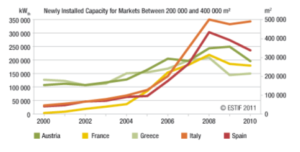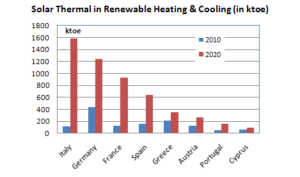Market Statistics: Three Studies Analyse Solar Thermal Market Development
July 18, 2012
Market development Brazil=
 There are signs that the strong decline of the European solar thermal market reported over the last two years came to a halt in 2011 – at least according to three market reports published in June 2012. On 11 June, the European Solar Thermal Industry Federation (ESTIF) presented its annual market statistics, and the REN21 Renewables 2012 Global Status Report was published as well. Only eight days later, the two reports were followed by the 2012 EurObserv’ER Solar Thermal Barometer.
There are signs that the strong decline of the European solar thermal market reported over the last two years came to a halt in 2011 – at least according to three market reports published in June 2012. On 11 June, the European Solar Thermal Industry Federation (ESTIF) presented its annual market statistics, and the REN21 Renewables 2012 Global Status Report was published as well. Only eight days later, the two reports were followed by the 2012 EurObserv’ER Solar Thermal Barometer.
ESTIF’s annual report Solar Thermal Markets in Europe – Trend and Market Statistics 2011 concluded that 2011 proved to be a year of mixed messages (see attachment). On average, the European market was stagnating: The newly installed solar thermal capacity decreased by -1.3 % to 2.56 GWth (3.66 million m2). The solar thermal industry recorded a turnover of around EUR 2.6 billion and employed 32,000 people full-time.
At the national level, however, market conditions looked very different. While Germany continued to be the sector’s driving force in 2011, Poland (+74%) was able to join the select group of markets above 140 MWth (200,000 m²) of newly installed capacity. Some markets went through a very difficult time, especially in South Europe. Italy (-15%), Spain (-21%) and Portugal (-30%) showed steep declines, whereas Greece (+8%) could resist the downwards trend and record a slight market growth. In ESTIF’s report, both large-scale systems for commercial heating and cooling applications above 35 kWth, as well as very large systems above 350 kWth, which are used in solar-assisted district heating or industrial process heat applications, showed positive developments. They alone, however, were not capable of reversing the negative trend experienced in most traditional market segments, such as domestic hot water production in single-family houses.
According to the EurObserv’ER Solar Thermal Barometer (see attachment), the hot water collector market continued to decrease in 2011, but less than in 2010. What can be said for certain is that the current difficulties on the European solar thermal markets can be blamed on the same factors as over the past two years: 2008’s financial crash and the recession that followed have been affecting the construction sector, particularly in South Europe. Another reason mentioned for the decrease in sales is the fact that the gas price is no longer linked to the oil price, which makes gas very competitive to solar energy. In the chapter “Ways out of the crisis”, the EurObserv’ER follows ESTIF’s argument of calling for significant efforts to reduce costs in the industry and a feed-in tariff, which would depend on the type of application and a solar fraction rate between 0.05 and 0.15 EUR/kWh (see also http://www.solarthermalworld.org/node/3125).
The EurObserv’ER Barometer is published regularly, containing indicators to reflect the current development of renewable energies (solar, wind, hydropower, geothermal and biomass, biogas, biofuels) worldwide and across the European Union. The solar thermal barometer covers the solar heating and cooling sector, as well as concentrating solar power.
The REN21 Renewables 2012 Global Status Report provides readers with updates on the state of technologies, investments, policies and other developments in the field of renewable energy in 2011. First released in 2005, REN21’s Renewables Global Status Report (GSR) has become a shared effort of over 400 authors, contributors and reviewers. The project is testimony to the growing number of electricity, heat, and fuel production capacities based on renewable energy sources, including solar PV, wind power, solar hot water/heating, biofuels, hydropower and geothermal. The 2012 edition of REN21’s Renewables Global Status Report (GSR) was published together with its sister report UNEP’s Global Trends in Renewable Energy Investment (GTR).
The GSR put together an interesting number of key figures and trends on the renewable energy world last year. First, the number of countries with renewable targets has more than doubled between 2005 and 2011, to 118 countries. There are also more and more cities and local governments promoting renewable energies around the globe. Second: more than 200 million households worldwide use solar thermal technology for hot water and space heating. Third: Investment in renewables has increased by 17% to a record USD 257 billion. With only a few pages (54-56), the solar heating and cooling chapter of the 172-page study is rather small and gathers its figures and trends from other publications.
More information:
http://www.estif.org
http://www.ren21.org
http://www.eurobserv-er.org/


